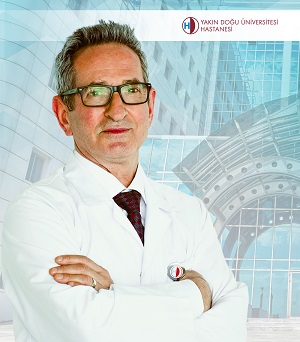
Prof. Dr. Ali Ulvi Önder from Near East University Hospital, Department of Urology, stated that epidemiological studies show that prostate cancer has both family and genetic features, roughly 2.2 times the risk of developing prostate cancer in a person with a PCa in his father, 2.4 times in those with his sibling, and 5 in the first-degree relatives.
Excessive consumption of unsaturated fat increases the risk of getting prostate cancer...
Prof. Dr. Ali Ulvi Önder “Prostate cancer is the most common cancer among men. One of the important risk factors is fat consumption. Excessive consumption of unsaturated fats and obesity increase the risk of both developing prostate cancer and developing malignant cancer. In addition, cigarette, red meat and animal fat consumption increases the risk of PCa, while lycopene (tomato, other red vegetables and fruits), selenium (cereal, fish, meat-poultry meat, eggs, dairy products), omega-3 fatty acids (fish), Vitamin D and E has an effect on reducing the risk of prostate cancer.”
If you have urinary difficulty, burning while urinating, frequent urination, night urination, urinary incontinence, bifurcation consult your physician...
Prof. Dr. Önder stated that the patient has complaints according to the degree of obstruction in the urinary tract caused by PCa, such as difficulty in urination, burning while urinating, frequent urination, urination at night, urinary incontinence, bifurcation, difficulty in keeping urine. Prof. Dr. Ali Ulvi Önder said, “In the presence of advanced stage or metastatic PCa, pain in the backbones may be the first complaint of the patient according to the part of the body where the disease has affected.”
A definitive diagnosis of prostate cancer can be made with a prostate biopsy ...
Explaining that the definitive diagnosis of prostate cancer is made by pathological examination of tissue obtained from prostate biopsy, Prof. Dr. Önder said, “The most important determinants of the biopsy decision are the DRE-Digital Rectal Examination of the prostate and the PSA (Prostate-Specific Antigen) test in the blood”.
Various imaging methods such as Computed Tomography or MRI, Whole Body Bone Scintigraphy, or PET for staging are also used.
Prof. Dr. Ali Ulvi Önder said, “The standard practice in prostate biopsy today is biopsy performed with the help of breech ultrasound (TRUS - transrectal ultrasound). In this application, the prostate is imaged through ultrasound and biopsy is performed systematically with the help of a special needle and gun. Generally, a total of 8-12 biopsies are taken and sent to the laboratory for pathological examination. The biopsy is performed without anesthesia or preferably under local anesthesia. If PCa is diagnosed as a result of biopsy, the stage of the disease is determined in order to make a treatment decision. Various imaging methods are used for staging, such as computed tomography or MRI, whole-body bone scintigraphy, or PET.”
There are 3 main stages in prostate cancer...
Prof. Dr. Ali Ulvi Önder “As with all cancer diseases, the treatment of prostate cancer is carried out in accordance with the stage of the disease. We can roughly divide the prostate cancer stage into 3 main groups. Organ-confined disease, locally advanced stage and advanced stage. The decision to treat PCa depends on factors such as the stage of the disease, biopsy data, the patient's state of health, and the patient's age.”
Standard treatment options by stage; Follow-up, Active Follow-up, Radiotherapy, Surgery...
Prof. Dr. Ali Ulvi Önder said, “We can list the standard treatment options according to the stages as follows. In organ-limited disease; a) Follow-up: Follow-up of the patient without any treatment. It is generally applied to older patients with low progression potential. b) Active Monitoring: It can be applied to patients who have a low progression potential, low PSA value, and who have cancer in 1 or at most 2 parts in their biopsy, repeating biopsy after a certain period. c) Radiotherapy: It is the inactivation of the tumor by placing radioactive nuclei from the outside or inside of the prostate. d) Surgery: Prostate cancer surgery is the removal of the entire prostate with the semen sac and the last part of the semen canal.
Treatment options in locally advanced disease are surgery and radiotherapy...
Stating that the treatment options in locally advanced disease are surgery and radiotherapy, Prof. Dr. Ali Ulvi Önder said, “Radiotherapy and surgical applications are for organ-limited disease, but combined treatments may be required at this stage since the risk of recurrence of the disease is high. "There may be hormonal treatment options before or after radiotherapy, hormonal treatment before and/or after surgery or radiotherapy treatment after surgery."
All diagnosis, staging methods and treatments related to prostate cancer are successfully performed at the Near East University Hospital ...
Prof. Dr. Ali Ulvi Önder finally said that all the treatment and staging methods related to prostate cancer, as well as all treatment options, are successfully carried out at the Near East University Hospital.